International Business Strategy: A Comprehensive Analysis
VerifiedAdded on 2022/08/21
|7
|1338
|15
Report
AI Summary
This report provides an in-depth analysis of international business strategy, covering key concepts and frameworks learned over a five-week period. The report begins with an introduction to international business perspectives, including macro and industry globalization drivers. It then delves into specific topics such as PEST analysis, Porter's 5 forces, and Porter's diamond, providing a foundation for understanding the global market. The discussion section examines the role of ecosystems in creating value, using examples like Google Inc. The report further explores the impact of artificial intelligence on the business landscape, highlighting its disruptive effects. The Blue Ocean Strategy is introduced, contrasting it with the Red Ocean Strategy, and emphasizing the importance of creating new markets for long-term success. The concept of a sustainable Blue Ocean Strategy is also discussed, focusing on minimizing costs and improving product value. Finally, the report concludes by examining the importance of core competencies in achieving a competitive advantage, emphasizing the need for unique and difficult-to-imitate capabilities. The report also includes a list of references.
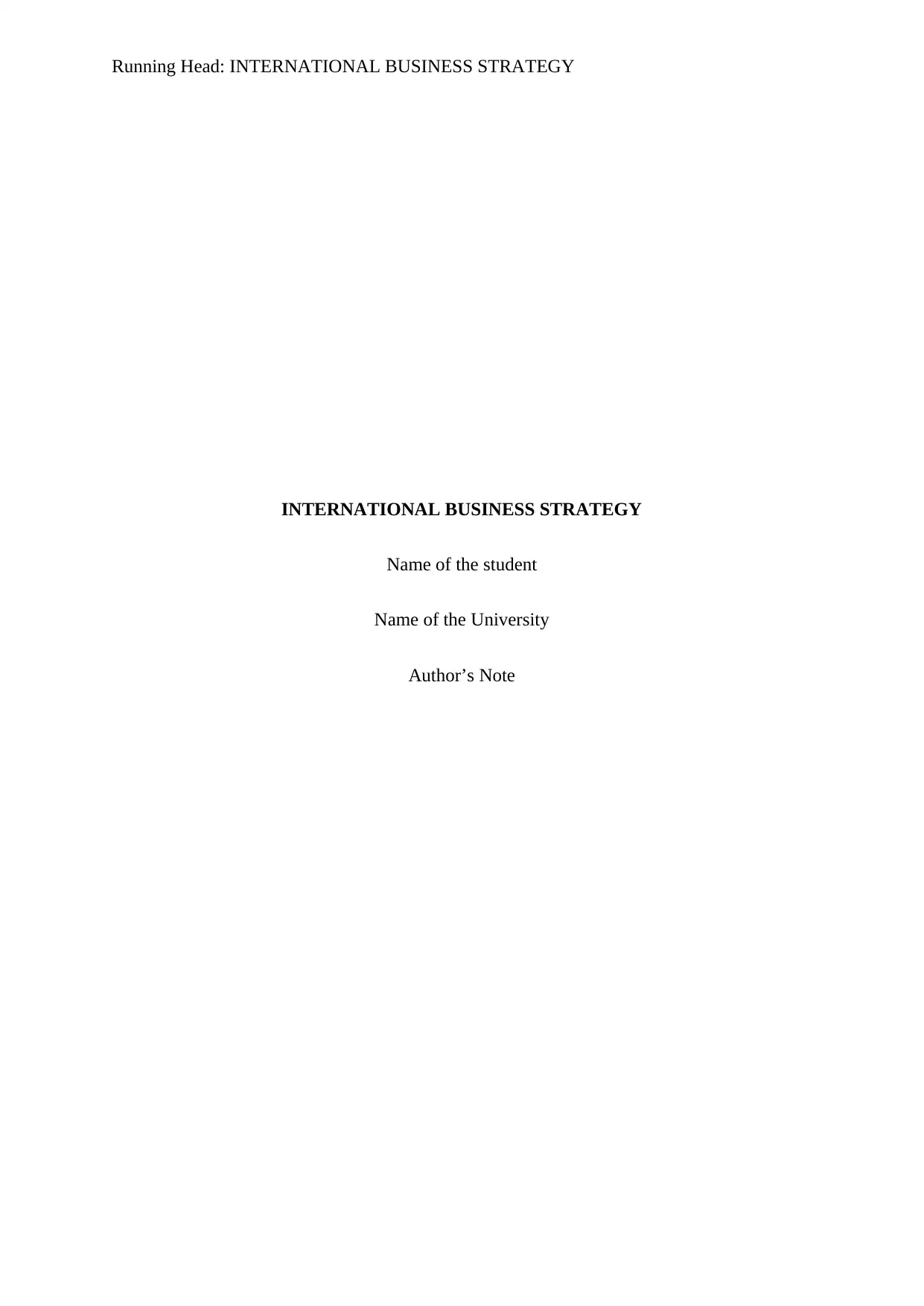
Running Head: INTERNATIONAL BUSINESS STRATEGY
INTERNATIONAL BUSINESS STRATEGY
Name of the student
Name of the University
Author’s Note
INTERNATIONAL BUSINESS STRATEGY
Name of the student
Name of the University
Author’s Note
Paraphrase This Document
Need a fresh take? Get an instant paraphrase of this document with our AI Paraphraser
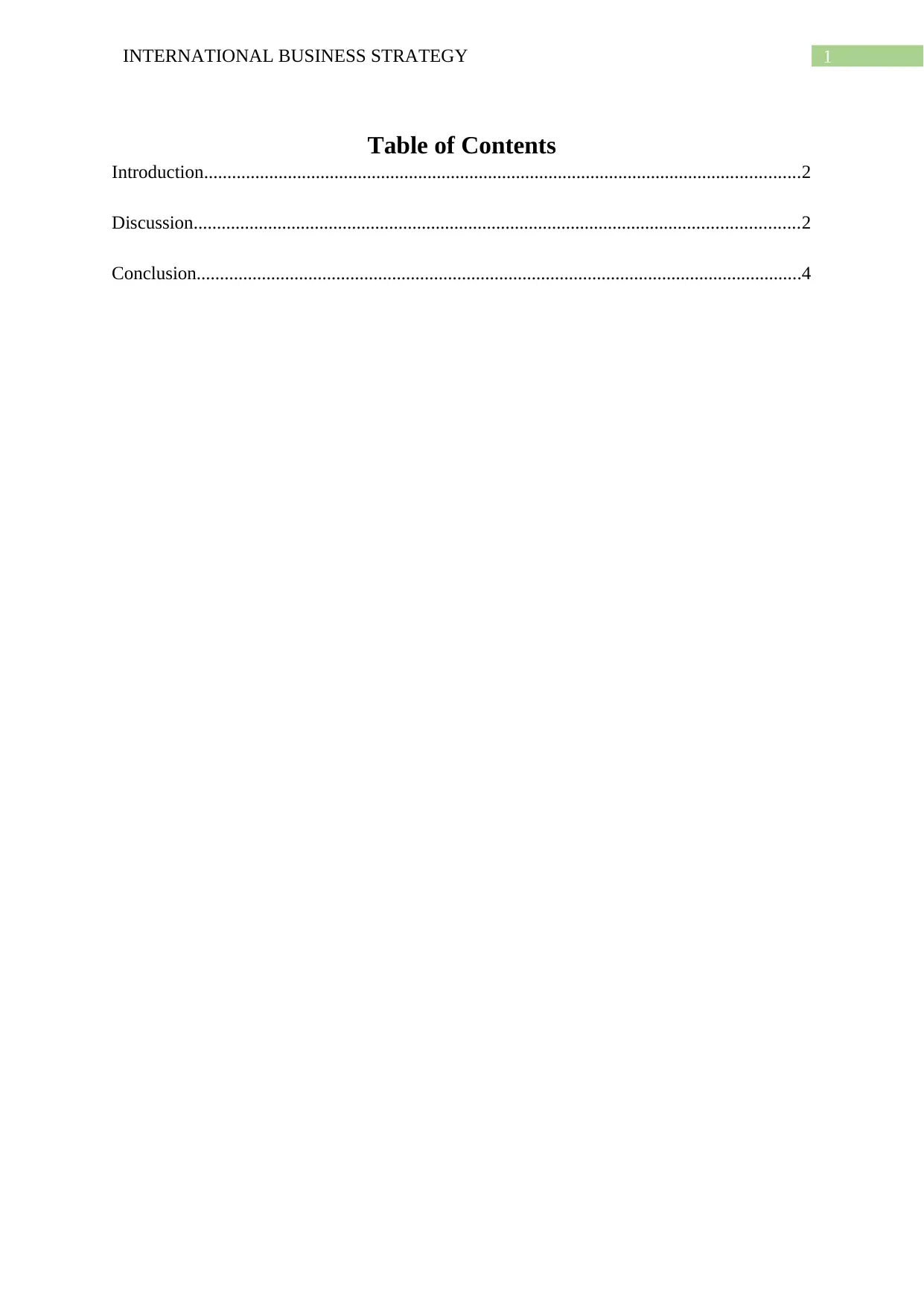
1INTERNATIONAL BUSINESS STRATEGY
Table of Contents
Introduction................................................................................................................................2
Discussion..................................................................................................................................2
Conclusion..................................................................................................................................4
Table of Contents
Introduction................................................................................................................................2
Discussion..................................................................................................................................2
Conclusion..................................................................................................................................4
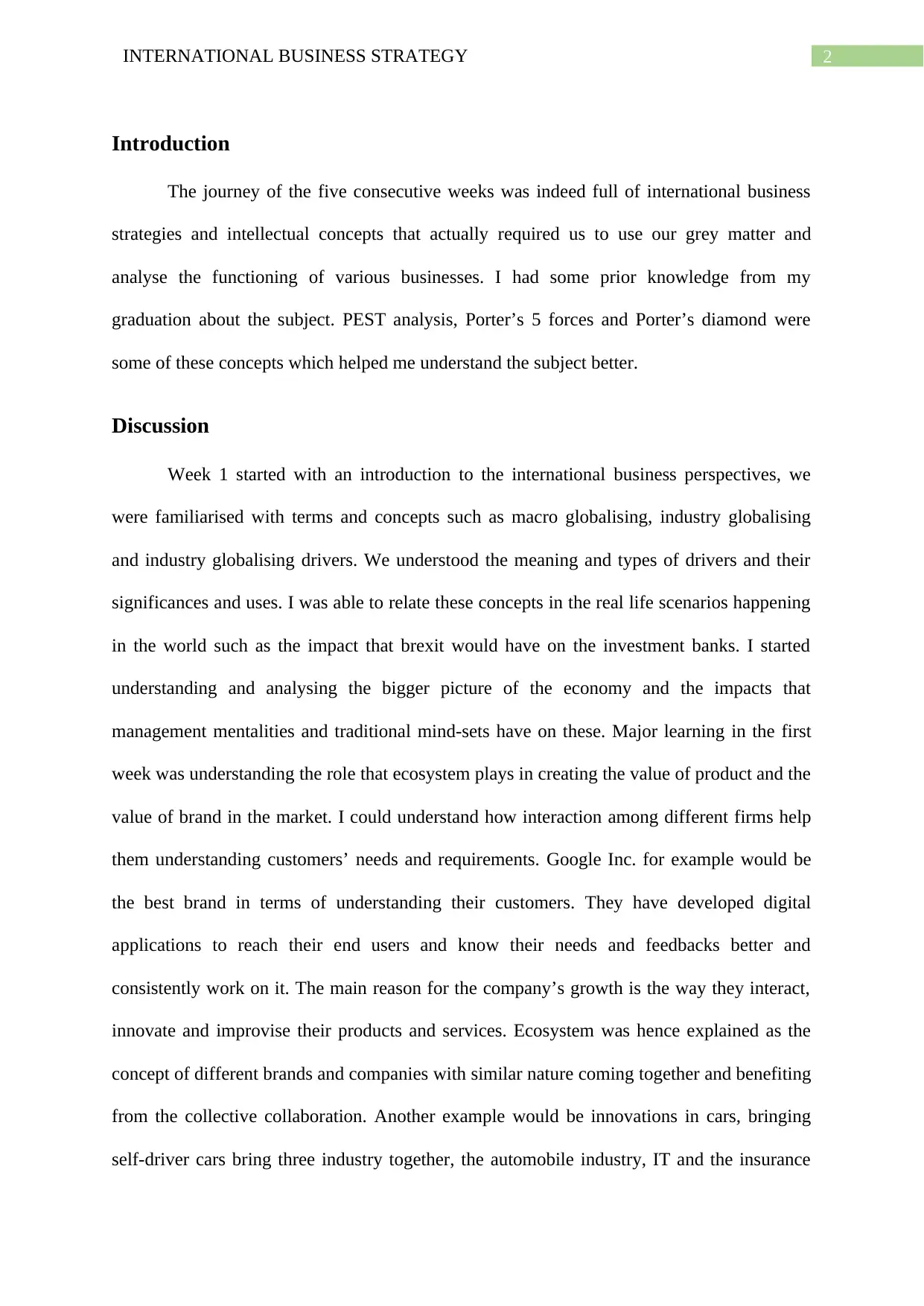
2INTERNATIONAL BUSINESS STRATEGY
Introduction
The journey of the five consecutive weeks was indeed full of international business
strategies and intellectual concepts that actually required us to use our grey matter and
analyse the functioning of various businesses. I had some prior knowledge from my
graduation about the subject. PEST analysis, Porter’s 5 forces and Porter’s diamond were
some of these concepts which helped me understand the subject better.
Discussion
Week 1 started with an introduction to the international business perspectives, we
were familiarised with terms and concepts such as macro globalising, industry globalising
and industry globalising drivers. We understood the meaning and types of drivers and their
significances and uses. I was able to relate these concepts in the real life scenarios happening
in the world such as the impact that brexit would have on the investment banks. I started
understanding and analysing the bigger picture of the economy and the impacts that
management mentalities and traditional mind-sets have on these. Major learning in the first
week was understanding the role that ecosystem plays in creating the value of product and the
value of brand in the market. I could understand how interaction among different firms help
them understanding customers’ needs and requirements. Google Inc. for example would be
the best brand in terms of understanding their customers. They have developed digital
applications to reach their end users and know their needs and feedbacks better and
consistently work on it. The main reason for the company’s growth is the way they interact,
innovate and improvise their products and services. Ecosystem was hence explained as the
concept of different brands and companies with similar nature coming together and benefiting
from the collective collaboration. Another example would be innovations in cars, bringing
self-driver cars bring three industry together, the automobile industry, IT and the insurance
Introduction
The journey of the five consecutive weeks was indeed full of international business
strategies and intellectual concepts that actually required us to use our grey matter and
analyse the functioning of various businesses. I had some prior knowledge from my
graduation about the subject. PEST analysis, Porter’s 5 forces and Porter’s diamond were
some of these concepts which helped me understand the subject better.
Discussion
Week 1 started with an introduction to the international business perspectives, we
were familiarised with terms and concepts such as macro globalising, industry globalising
and industry globalising drivers. We understood the meaning and types of drivers and their
significances and uses. I was able to relate these concepts in the real life scenarios happening
in the world such as the impact that brexit would have on the investment banks. I started
understanding and analysing the bigger picture of the economy and the impacts that
management mentalities and traditional mind-sets have on these. Major learning in the first
week was understanding the role that ecosystem plays in creating the value of product and the
value of brand in the market. I could understand how interaction among different firms help
them understanding customers’ needs and requirements. Google Inc. for example would be
the best brand in terms of understanding their customers. They have developed digital
applications to reach their end users and know their needs and feedbacks better and
consistently work on it. The main reason for the company’s growth is the way they interact,
innovate and improvise their products and services. Ecosystem was hence explained as the
concept of different brands and companies with similar nature coming together and benefiting
from the collective collaboration. Another example would be innovations in cars, bringing
self-driver cars bring three industry together, the automobile industry, IT and the insurance
⊘ This is a preview!⊘
Do you want full access?
Subscribe today to unlock all pages.

Trusted by 1+ million students worldwide
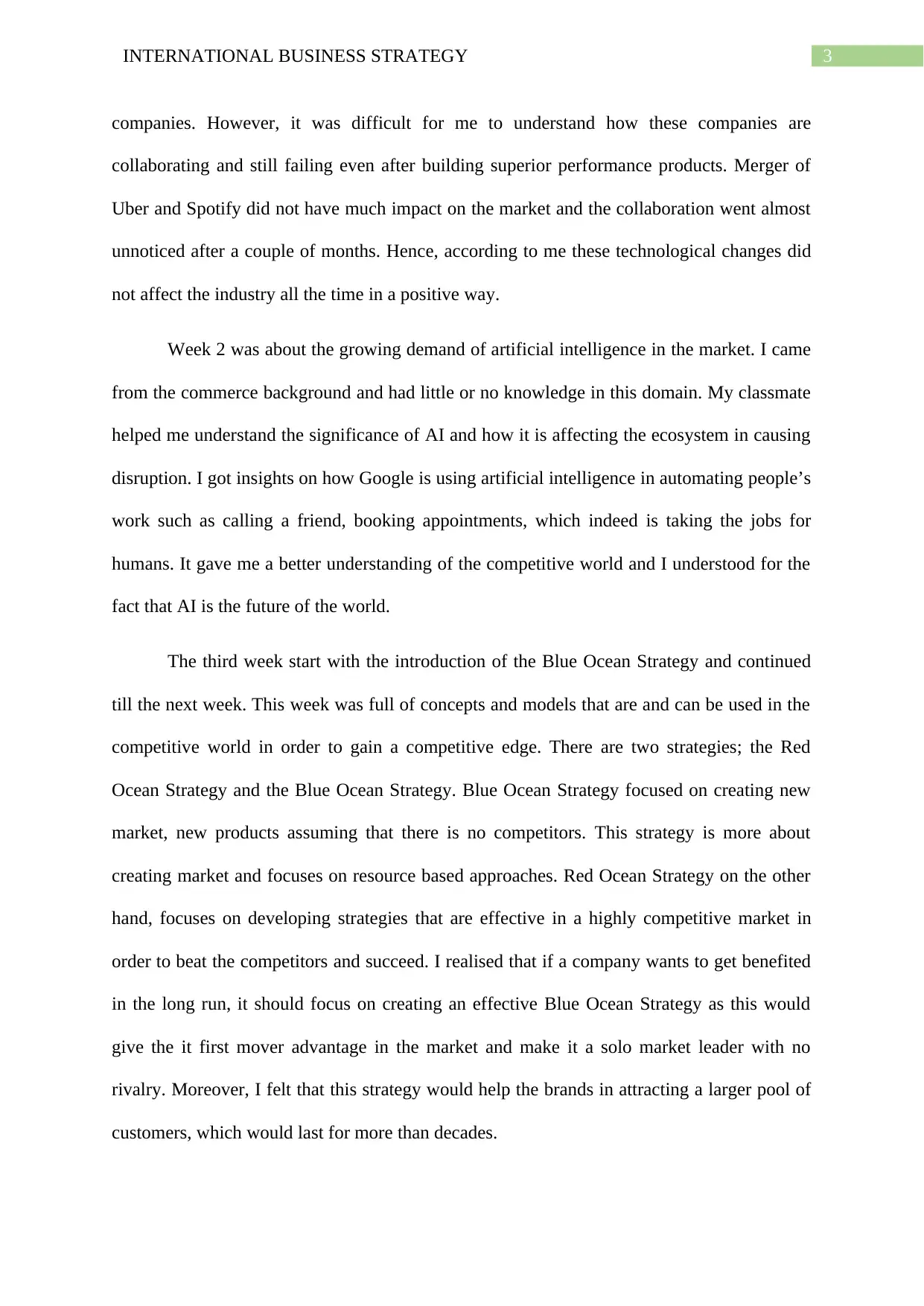
3INTERNATIONAL BUSINESS STRATEGY
companies. However, it was difficult for me to understand how these companies are
collaborating and still failing even after building superior performance products. Merger of
Uber and Spotify did not have much impact on the market and the collaboration went almost
unnoticed after a couple of months. Hence, according to me these technological changes did
not affect the industry all the time in a positive way.
Week 2 was about the growing demand of artificial intelligence in the market. I came
from the commerce background and had little or no knowledge in this domain. My classmate
helped me understand the significance of AI and how it is affecting the ecosystem in causing
disruption. I got insights on how Google is using artificial intelligence in automating people’s
work such as calling a friend, booking appointments, which indeed is taking the jobs for
humans. It gave me a better understanding of the competitive world and I understood for the
fact that AI is the future of the world.
The third week start with the introduction of the Blue Ocean Strategy and continued
till the next week. This week was full of concepts and models that are and can be used in the
competitive world in order to gain a competitive edge. There are two strategies; the Red
Ocean Strategy and the Blue Ocean Strategy. Blue Ocean Strategy focused on creating new
market, new products assuming that there is no competitors. This strategy is more about
creating market and focuses on resource based approaches. Red Ocean Strategy on the other
hand, focuses on developing strategies that are effective in a highly competitive market in
order to beat the competitors and succeed. I realised that if a company wants to get benefited
in the long run, it should focus on creating an effective Blue Ocean Strategy as this would
give the it first mover advantage in the market and make it a solo market leader with no
rivalry. Moreover, I felt that this strategy would help the brands in attracting a larger pool of
customers, which would last for more than decades.
companies. However, it was difficult for me to understand how these companies are
collaborating and still failing even after building superior performance products. Merger of
Uber and Spotify did not have much impact on the market and the collaboration went almost
unnoticed after a couple of months. Hence, according to me these technological changes did
not affect the industry all the time in a positive way.
Week 2 was about the growing demand of artificial intelligence in the market. I came
from the commerce background and had little or no knowledge in this domain. My classmate
helped me understand the significance of AI and how it is affecting the ecosystem in causing
disruption. I got insights on how Google is using artificial intelligence in automating people’s
work such as calling a friend, booking appointments, which indeed is taking the jobs for
humans. It gave me a better understanding of the competitive world and I understood for the
fact that AI is the future of the world.
The third week start with the introduction of the Blue Ocean Strategy and continued
till the next week. This week was full of concepts and models that are and can be used in the
competitive world in order to gain a competitive edge. There are two strategies; the Red
Ocean Strategy and the Blue Ocean Strategy. Blue Ocean Strategy focused on creating new
market, new products assuming that there is no competitors. This strategy is more about
creating market and focuses on resource based approaches. Red Ocean Strategy on the other
hand, focuses on developing strategies that are effective in a highly competitive market in
order to beat the competitors and succeed. I realised that if a company wants to get benefited
in the long run, it should focus on creating an effective Blue Ocean Strategy as this would
give the it first mover advantage in the market and make it a solo market leader with no
rivalry. Moreover, I felt that this strategy would help the brands in attracting a larger pool of
customers, which would last for more than decades.
Paraphrase This Document
Need a fresh take? Get an instant paraphrase of this document with our AI Paraphraser
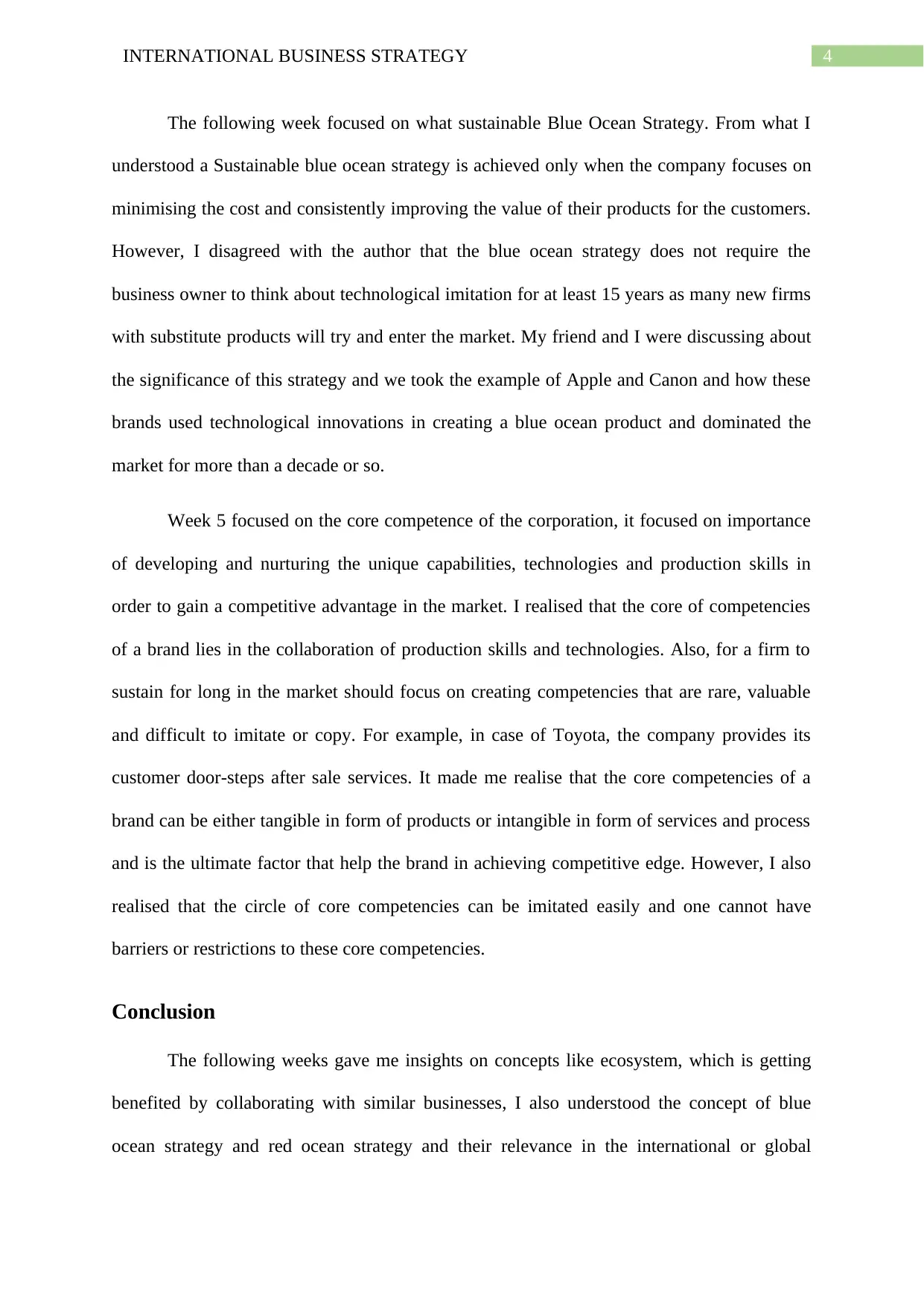
4INTERNATIONAL BUSINESS STRATEGY
The following week focused on what sustainable Blue Ocean Strategy. From what I
understood a Sustainable blue ocean strategy is achieved only when the company focuses on
minimising the cost and consistently improving the value of their products for the customers.
However, I disagreed with the author that the blue ocean strategy does not require the
business owner to think about technological imitation for at least 15 years as many new firms
with substitute products will try and enter the market. My friend and I were discussing about
the significance of this strategy and we took the example of Apple and Canon and how these
brands used technological innovations in creating a blue ocean product and dominated the
market for more than a decade or so.
Week 5 focused on the core competence of the corporation, it focused on importance
of developing and nurturing the unique capabilities, technologies and production skills in
order to gain a competitive advantage in the market. I realised that the core of competencies
of a brand lies in the collaboration of production skills and technologies. Also, for a firm to
sustain for long in the market should focus on creating competencies that are rare, valuable
and difficult to imitate or copy. For example, in case of Toyota, the company provides its
customer door-steps after sale services. It made me realise that the core competencies of a
brand can be either tangible in form of products or intangible in form of services and process
and is the ultimate factor that help the brand in achieving competitive edge. However, I also
realised that the circle of core competencies can be imitated easily and one cannot have
barriers or restrictions to these core competencies.
Conclusion
The following weeks gave me insights on concepts like ecosystem, which is getting
benefited by collaborating with similar businesses, I also understood the concept of blue
ocean strategy and red ocean strategy and their relevance in the international or global
The following week focused on what sustainable Blue Ocean Strategy. From what I
understood a Sustainable blue ocean strategy is achieved only when the company focuses on
minimising the cost and consistently improving the value of their products for the customers.
However, I disagreed with the author that the blue ocean strategy does not require the
business owner to think about technological imitation for at least 15 years as many new firms
with substitute products will try and enter the market. My friend and I were discussing about
the significance of this strategy and we took the example of Apple and Canon and how these
brands used technological innovations in creating a blue ocean product and dominated the
market for more than a decade or so.
Week 5 focused on the core competence of the corporation, it focused on importance
of developing and nurturing the unique capabilities, technologies and production skills in
order to gain a competitive advantage in the market. I realised that the core of competencies
of a brand lies in the collaboration of production skills and technologies. Also, for a firm to
sustain for long in the market should focus on creating competencies that are rare, valuable
and difficult to imitate or copy. For example, in case of Toyota, the company provides its
customer door-steps after sale services. It made me realise that the core competencies of a
brand can be either tangible in form of products or intangible in form of services and process
and is the ultimate factor that help the brand in achieving competitive edge. However, I also
realised that the circle of core competencies can be imitated easily and one cannot have
barriers or restrictions to these core competencies.
Conclusion
The following weeks gave me insights on concepts like ecosystem, which is getting
benefited by collaborating with similar businesses, I also understood the concept of blue
ocean strategy and red ocean strategy and their relevance in the international or global
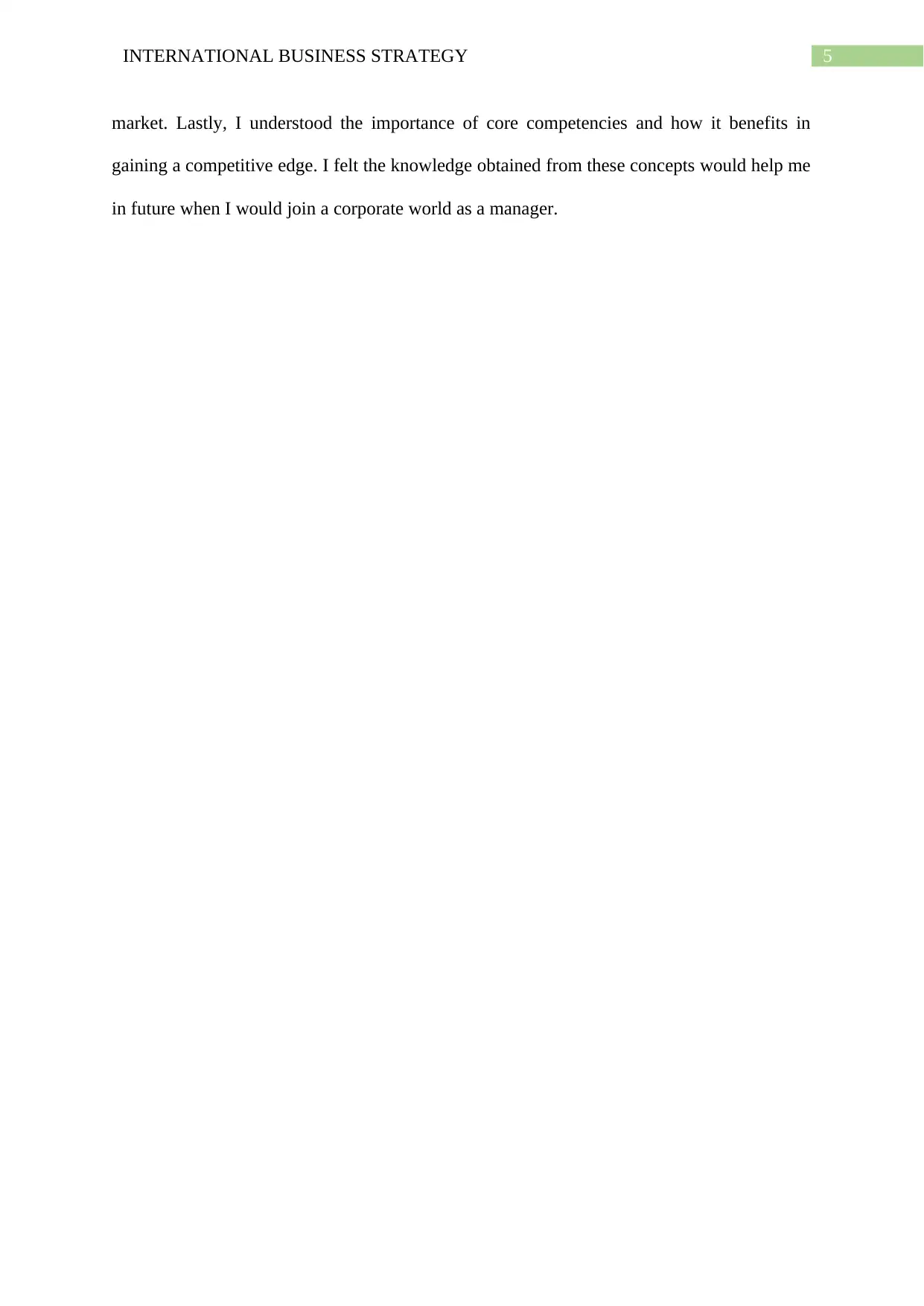
5INTERNATIONAL BUSINESS STRATEGY
market. Lastly, I understood the importance of core competencies and how it benefits in
gaining a competitive edge. I felt the knowledge obtained from these concepts would help me
in future when I would join a corporate world as a manager.
market. Lastly, I understood the importance of core competencies and how it benefits in
gaining a competitive edge. I felt the knowledge obtained from these concepts would help me
in future when I would join a corporate world as a manager.
⊘ This is a preview!⊘
Do you want full access?
Subscribe today to unlock all pages.

Trusted by 1+ million students worldwide
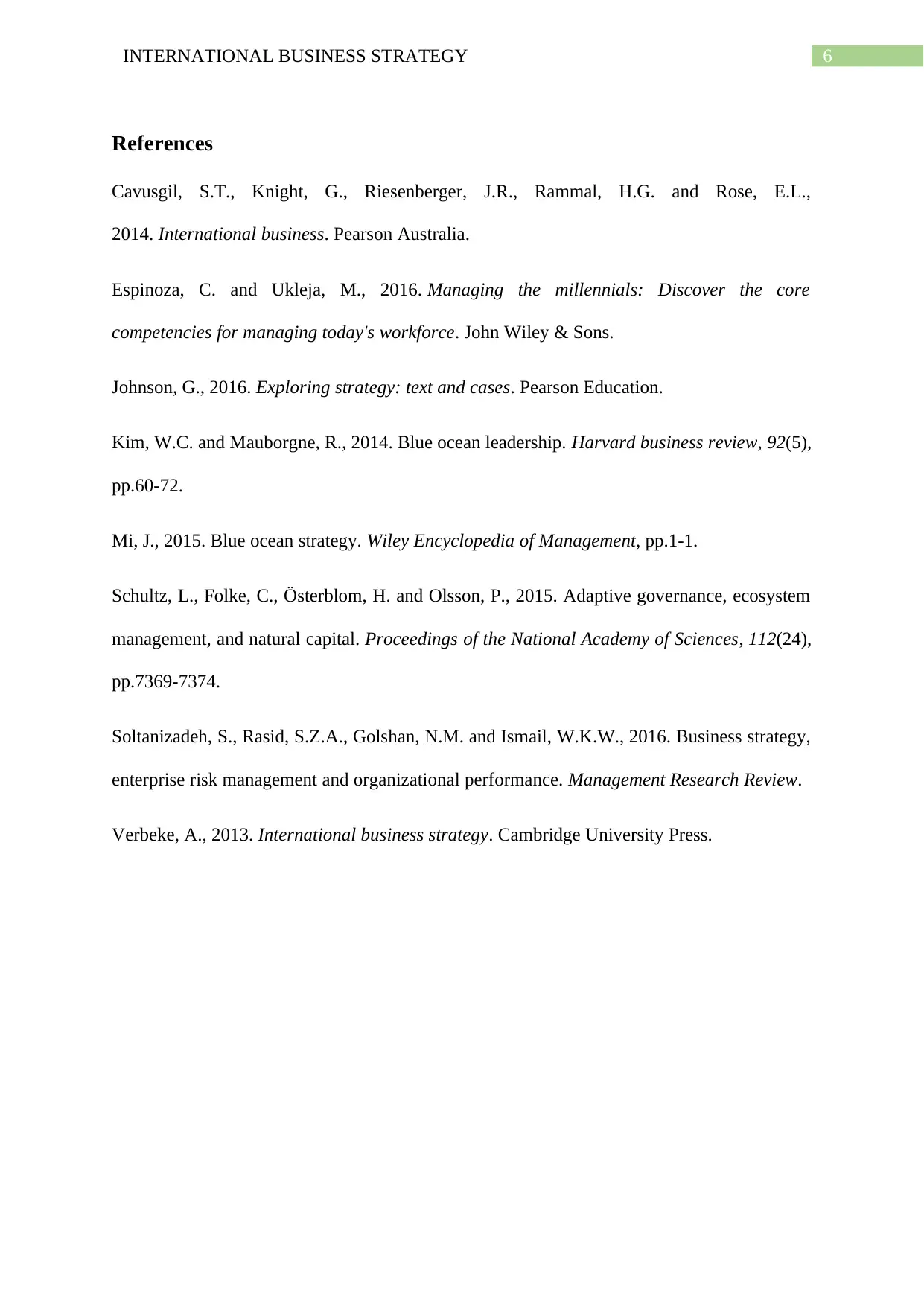
6INTERNATIONAL BUSINESS STRATEGY
References
Cavusgil, S.T., Knight, G., Riesenberger, J.R., Rammal, H.G. and Rose, E.L.,
2014. International business. Pearson Australia.
Espinoza, C. and Ukleja, M., 2016. Managing the millennials: Discover the core
competencies for managing today's workforce. John Wiley & Sons.
Johnson, G., 2016. Exploring strategy: text and cases. Pearson Education.
Kim, W.C. and Mauborgne, R., 2014. Blue ocean leadership. Harvard business review, 92(5),
pp.60-72.
Mi, J., 2015. Blue ocean strategy. Wiley Encyclopedia of Management, pp.1-1.
Schultz, L., Folke, C., Österblom, H. and Olsson, P., 2015. Adaptive governance, ecosystem
management, and natural capital. Proceedings of the National Academy of Sciences, 112(24),
pp.7369-7374.
Soltanizadeh, S., Rasid, S.Z.A., Golshan, N.M. and Ismail, W.K.W., 2016. Business strategy,
enterprise risk management and organizational performance. Management Research Review.
Verbeke, A., 2013. International business strategy. Cambridge University Press.
References
Cavusgil, S.T., Knight, G., Riesenberger, J.R., Rammal, H.G. and Rose, E.L.,
2014. International business. Pearson Australia.
Espinoza, C. and Ukleja, M., 2016. Managing the millennials: Discover the core
competencies for managing today's workforce. John Wiley & Sons.
Johnson, G., 2016. Exploring strategy: text and cases. Pearson Education.
Kim, W.C. and Mauborgne, R., 2014. Blue ocean leadership. Harvard business review, 92(5),
pp.60-72.
Mi, J., 2015. Blue ocean strategy. Wiley Encyclopedia of Management, pp.1-1.
Schultz, L., Folke, C., Österblom, H. and Olsson, P., 2015. Adaptive governance, ecosystem
management, and natural capital. Proceedings of the National Academy of Sciences, 112(24),
pp.7369-7374.
Soltanizadeh, S., Rasid, S.Z.A., Golshan, N.M. and Ismail, W.K.W., 2016. Business strategy,
enterprise risk management and organizational performance. Management Research Review.
Verbeke, A., 2013. International business strategy. Cambridge University Press.
1 out of 7
Related Documents
Your All-in-One AI-Powered Toolkit for Academic Success.
+13062052269
info@desklib.com
Available 24*7 on WhatsApp / Email
![[object Object]](/_next/static/media/star-bottom.7253800d.svg)
Unlock your academic potential
Copyright © 2020–2025 A2Z Services. All Rights Reserved. Developed and managed by ZUCOL.



